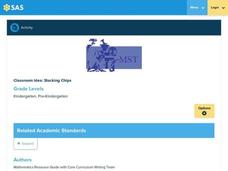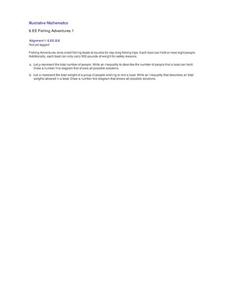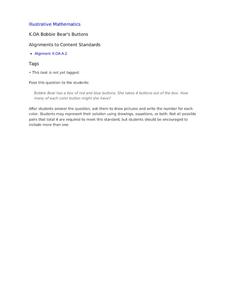Pennsylvania Department of Education
Using the Number Line to Compare
Students determine differences using a number line. In this math lesson, students use the number line to solve subtraction problems. Students solve puzzles using subtraction.
Pennsylvania Department of Education
Geoboards
Learners describe shapes to their classmates using specific properties and practice making triangles on geoboards. In this geoboards lesson plan, students use string on the geoboards.
Curated OER
Exploring Patterns
Young scholars explore patterns. In this math lesson, students use a variety of objects to create patterns. Young scholars answer questions about the patterns they create.
Pennsylvania Department of Education
Sorting Buttons
Students demonstrate how to sort buttons by attributes. In this classification instructional activity, students are given buttons and are asked to sort them independently by their attributes. Additionally, students are given one extra...
Pennsylvania Department of Education
Counting People
Learners practice counting. For this counting activity, students are used to help visually represent a number for their classmates.
Pennsylvania Department of Education
Stacking Chips
Students examine the outcome of adding one to a group of items. In this number sense lesson, students create stacks of chips and count them. Then, students add one more chip to the stack and count the chips again. Students discuss their...
Pennsylvania Department of Education
Associative Properties
Students investigate the associative property of addition. In this associative property of addition lesson, students work in pairs and build addition problems with six blocks. They sit on either side of a desk so that they can "read" the...
Pennsylvania Department of Education
Modeling Spatial Relationships
Students model spatial relationships using math manipulatives. For this spatial relationships lesson, students work with a partner, and either connecting links or linking cubes that are three different colors. They explain to each other...
Pennsylvania Department of Education
Guess the Container
Students become familiar with appropriate containers for various shapes. In this container lesson, students find containers that best fit their object.
Pennsylvania Department of Education
Months of the Year
Pupils develop a pictograph using the months of the year. In this months lesson, students place their name with their birth month on a large pictograph. They discuss the information they can see on the graph using the proper names for...
Curated OER
Classroom Idea: Building a Road
Students explore technology by conducting a infrastructure role-play in class. In this road building lesson, students identify the techniques and manpower used to build a modern day road. Students utilize building blocks to create a mock...
Curated OER
Estimation Skills
Students use a balance scale with beans or seeds to estimate how many of them would weigh as much as a teddy bear counter. In this estimation lesson plan, students hold items to estimate.
Curated OER
Making Graphs
Students explore statistics by conducting class demographic surveys. In this graph making instructional activity, students identify the family members of each classmate, pets they own, and favorite activities. Students organize their...
Curated OER
Indoor and Outdoor Patterns
Students explore geometry by participating in a visual illustration activity. In this pattern identification lesson, students explore inside their classroom and discuss patterns they find while tracing them on paper. Students attend an...
Illustrative Mathematics
Fishing Adventures 1
Often inequalities exist in many real-world contexts but young math learners struggle with understanding how to represent that relationship in a simple equation using an inequality. This activity focuses on the basic concepts by using...
Curated OER
Introduce Vocabulary: Peter's Chair (Keats)
A new baby means a lot of changes for Peter! Ezra Jack Keats presents this common childhood experience in his story Peter's Chair, the context of a detailed vocabulary study. Before you read, introduce the three new words scholars...
Illustrative Mathematics
A Bobbie Bear's Buttons
Young mathematicians help Bobbie Bear pick colored buttons out of a box as they learn how to decompose numbers less than 10 into pairs of smaller numbers. To support students with the process, consider creating a worksheet or graphic...
Curated OER
Memory Uses
Students discuss importance of memory, identify products that have memory, explain difference between three stages of memory, including immediate, short-term, and long-term, watch video, and use short-term memory to play memory game.
Pennsylvania Department of Education
Some Special Sums
Students study addition. For this math lesson, students solve doubles and doubles plus one addition facts. Students roll dice and use the numbers to create addition problems.
Pennsylvania Department of Education
Multiple Patterns
Students explore patterns that involve doubling numbers. In this multiple patterns lesson, students use objects to explore these patterns while recording them using a table. Students recognize even and odd number patterns while applying...
Curated OER
Keynote Digital Parts of Speech
Students create a parts of speech digital presentation. In this parts of speech lesson, students create a slide show with audio, pictures, movies, and text. They combine their slides to project the entire project.
Pennsylvania Department of Education
How Many Mats?
Young scholars count how many mats are put in a group. in this counting lesson plan, students are put into groups and count how many mats they have.
Curated OER
The Whole is More Than Half
Students explore number sense by completing a food related fraction activity. In this parts of a whole lesson, students utilize a graham cracker to divide and identify what a quarter, third, or half looks like. Students eat their snack...
Pennsylvania Department of Education
Problem-Solving
Students help solve real-life classroom problems. In this problem solving activity, the class sits down as a whole and discusses possible solutions to real problems that they face as a class.























